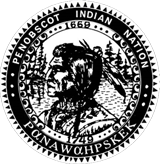Fisheries
The fisheries program, through its biologist, manages and monitors fisheries resources on Tribal trust lands. The PIN is represented by its biologist in the development and implementation of fisheries management plans for the Penobscot River with State of Maine and Federal resource agencies. The PIN biologist also represents Tribal interests in the relicensing of hydroelectric dams, the formation and execution of fish passage studies associated with relicensing and the protection of endangered and threatened fish species at hydroelectric dams.
Sea-run Fish
Sea-run, or Diadromous fishes were the dominant group of fish species in Penobscot River until the coming of the Industrial Age to Maine. The building of mill dams on small streams, to larger streams, to large dams crossing the mainstem of the Penobscot River cut off these fish from the habitats required to complete their life cycle. The alewives, blueback herring, American shad, American eel and Atlantic salmon that once fed a nation are all but gone from the Penobscot river.
The PIN biologist works collaboratively with state and federal resource agencies to restore these fish so important to the cultural history of the PIN.
Aquatic Connectivity
100% connectivity in a watershed means that the small upland tributaries are all connected to the mainstem of the river. A connected watershed is one in which water, nutrients, sediment, fish and other aquatic organisms can all freely move back and forth between habitats. Connectivity has been severely impaired in most New England watersheds for many generations due to the building of lake outlet dams, mill dams, and roads with improperly sized culverts and bridges. Culverts were originally used to move water to keep roads dry, not to allow for natural stream processes to occur. Many of these poorly sized culverts that exist on tribal trust lands are continually being updated.
Focus for the past 10 years has been on Tribal trust lands in the Mattamiscontis Stream drainage. Over 20 stream connectivity projects have been completed, to include rebuilding the outlets of Mattamiscontis, South Branch, and East Branch lakes. As the populations of alewives and blueback herring grow in these newly restored systems, the opportunities for Tribal substance harvests become available.
